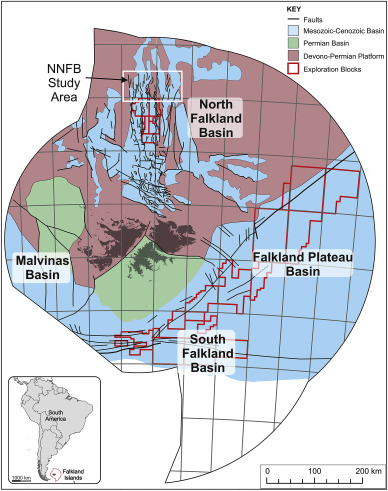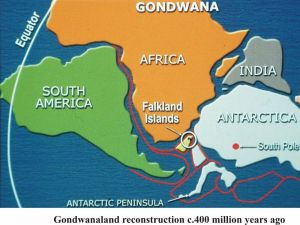Regional Geology
The Falkland Islands are situated on the Falkland Plateau, an area of continental crust that extends towards South Georgia. The Islands are composed of Pre-Cambrian to Permian rocks and surrounded by four sedimentary basins with thick Mesozoic and thinner Cenozoic sediments, each of which has underexplored petroleum potential. These basins are the Falkland Plateau Basin, the South Falkland Basin, the Malvinas Basin, and the North Falkland Basin.
Basin Introduction and Drilling History
North Falkland Basin (NFB)
NFB is a failed rift basin with a predominantly lacustrine infill. Six unsuccessful wells were drilled in 1998, five of which showed oil and gas, leading to further exploration. In the subsequent drilling campaign in 2010-12, the Sea Lion oilfield and its associated nearby satellite fields were discovered on the eastern flank of the basin, while the Liz field was discovered on the western flank.
Falkland Plateau Basin (FPB)
FPB is a passive margin basin with mostly marine infill. Three wells were drilled in the basin, with one being dry and the other two encountering non-flowing gas in the deeper water north-eastern parts of the basin.
South Falkland Basin (SFB)
SFB consists of a thrust belt and foreland basin with marine sedimentary rocks. Two wells were drilled in 2012, with one encountering technical issues and the other, drilled in the foreland basin, resulting in a gas condensate discovery named Darwin.
Jones, D. J., McCarthy, D. J., & Dodd, T. J. (2019)
General setting of the offshore sedimentary basins
The Southern Basins, including the Falkland Plateau Basin, Malvinas Basin, and South Falkland Basin, are interconnected and have varying tectono-stratigraphic histories. The Falkland Plateau Basin has a faulted western margin and terminates at the Maurice Ewing Bank, while the Malvinas Basin has a generally unfaulted eastern margin. The South Falkland Basin trends east-west along the northern side of the Scotia/South America plate boundary and plunges steeply to the south. The North Falkland Basin is structurally isolated within the Falkland Plateau. The regional geology and palaeogeographic evolution of the offshore Falkland Islands have been well documented by various researchers.
The Plate Tectonic Framework
The Falkland Plateau was likely adjacent to the eastern coast of southern Africa before the South Atlantic opened. The hypothesis of micro-plate rotation controlling the area's development is generally accepted, but offshore mapping by the British Geological Survey has cast doubt on this. They instead suggest that the Falklands Plateau is a fixed, rigid plate that translated to its present position without micro-plate rotation. However, the available onshore evidence supports the rotational hypothesis, according to Stone et.al. (2009).


